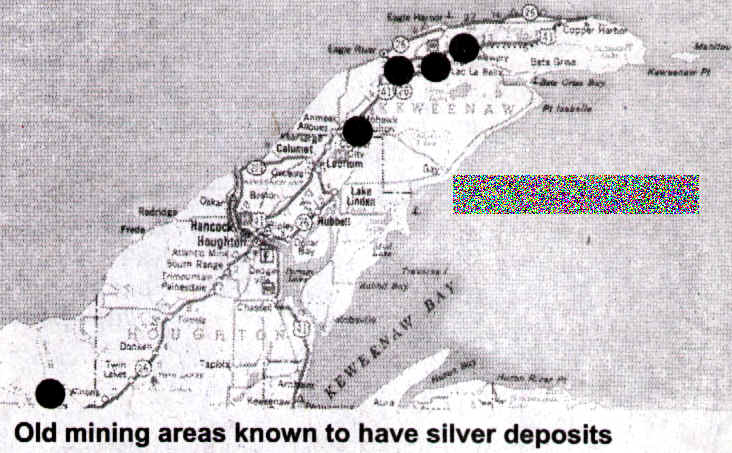Michigan has a variety of economically-valuable minerals, including the obvious ones like iron and copper, but also the more obscure ones like gypsum, clay, marl, limestone, and peat (among others). Michigan ranks first in the United States in the production of calcium chloride (salt) and in gypsum, fourth in cement and sand and gravel, and is a large producer of crushed stone for a variety of purposes. These minerals are found in the sedimentary rocks of the Michigan Basin or in the extensive glacial deposits.
Scan the map below to get a better picture of "what and where" with respect to Michigan's minerals.
Source: Unknown
Glacial drift is the most varied resource we have. The granitic boulders
supply stone for all sorts of buildings from foundations
to complete structures, from markers to monuments. Look at the foundations of the houses
on your street and no doubt you will see few houses that have a granite or crystalline
rock foundation. Foundation stones-"hard heads", "glacial babies"- are
fireplace stones, stones for rock gardens and fences. In the gravel beds of the moraines,
spillways, outwash plains, old lake beaches, and river deltas are supplies of pure water--the most used resource in the state. They contain water
imprisoned as the ice melted, and are replenished by rainfall. The gravels of the eskers,
kames, interlobate outwash plains, glacial lake beaches supply aggregate for concrete and highway construction and the
building industries. It is no wonder that Michigan has fine highways--we have everything
in the state with which to build them.
Source: Michigan Trend Futures Report,
Michigan Society of Planning, 1997
The largest gravel operation in the world is in the interlobate area of Oakland and
Livingston counties. Incidentally every gravel pit is an unassorted rock museum and more
schools are using them as natural outdoor classrooms.
Looking at the mineral industry of the state as a whole, the petroleum,
natural gas, and iron-ore sectors dominate in terms of total value of production. These
industries are followed by the cement, natural saline, and sand and gravel segments. The
leading mineral-producing counties are Marquette (iron ore), Manistee (oil and gas), Grand
Traverse (oil and gas), Wayne (salt, industrial and glass sand, and sand and gravel),
Otsego (oil and gas), Alpena (cement and limestone), Mason (salt, lime, and sand and
gravel), Dickinson (iron ore), and Kalkaska (oil and gas). Sand and gravel are widespread
resources that give almost every county some mineral production, and the future success of
the deep oil and gas finds may considerably alter the leading mineral areas in terms of
value. The diversity of Michigan’s geology has resulted in marked contrasts among the
type, value, and distributional patterns of the minerals.
Hunting for copper and silver
The huge copper deposits of the UP were also accompanied by reasonable amounts of silver. The tailings from these mines contain both copper and silver. Today this part of Michigan has become a "paradise" for explorers with metal detectors. Why spend time looking for coins in the park when rare copper, silver and half-breed specimens are available in the UP? Many people have found specimens valued to $1,000; some have sold for up to $35,000. It is a rare occasion when a field trip doesn’t pay for itself, if you know where to look. Occasionally a prehistoric copper relic will be found as well as mining relics from historic times. Keep your eyes open, learn a bit about rockhounding; being able to recognize datalite, thompsonites, greenstones, agates and other minerals can make your trips more successful.
What should you look for in metal specimens? Examine any specimen for silver inclusions (half-breed specimens are copper with silver on it; or more rare, silver with copper on it). Also look for any crystallization of the silver or copper. These specimens are in good demand and bring good prices. The Seamans Museum in Houghton has a large display of the area’s minerals. Check out their display specimens before you "hit the rocks." The rock and mineral shops in the area also have specimens for sale. Once you know what to look for, if you’re willing to work, you will find it.

Source:
Michigan State University - Department of Geography
Where to look? Much copper is available on the old mine dumps,
but digging is required as most surface material has already been detected. Some of the
best hunting is in the dumps at the old Cliff, Phoenix, Central, Copper Falls and Delaware
areas. Many "prospectors" prefer Keweenaw County, but many good specimens come
from the Old Mass and Adventure areas on the west end of the Copper
Range. Many other old mines were in this area, and a little research will provide
information on the specimens available. Almost any mine dump will have some copper in it,
in case you can't find silver.
This material has been compiled for educational use only, and may not be reproduced without permission. One copy may be printed for personal use. Please contact Randall Schaetzl (soils@msu.edu) for more information or permissions.